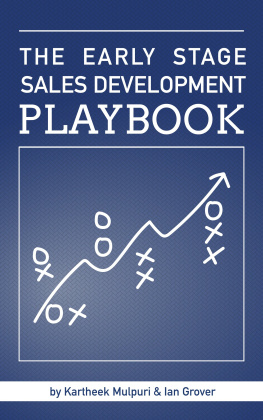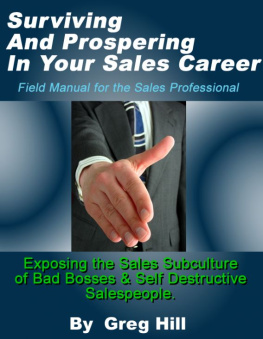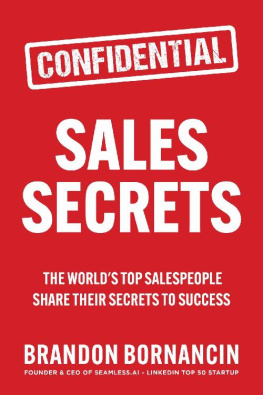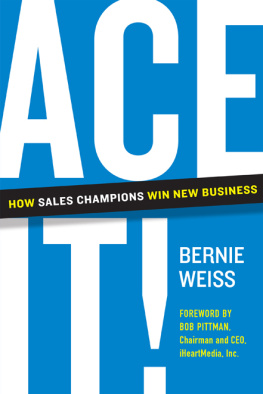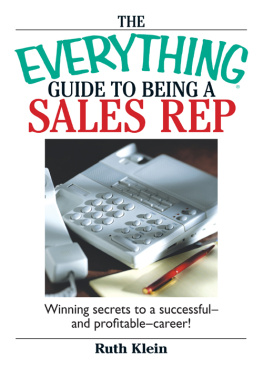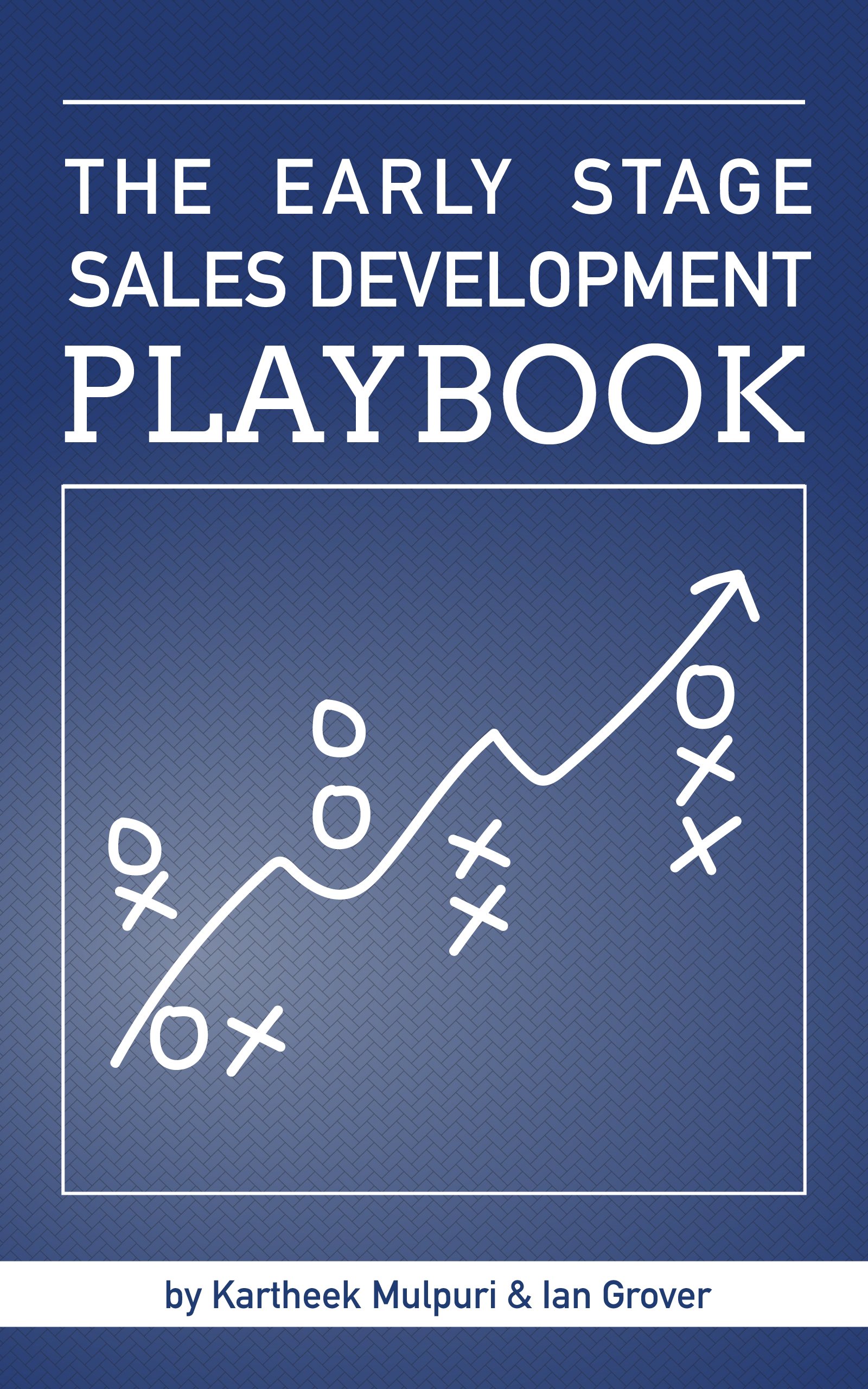Copyright 2020 Kartheek Mulpuri. All rights reserved. No portion of this work may be copied, redistributed, or reproduced in any manner without prior consent of the copyright holder.
Designed by Kelley Creative using resources from Vecteezy.
Contents
Introduction

Ive spent ten years in the technology industry in many roles with companies at different stages. Ive owned sales operations at an early stage company that had an exit, set up a lead generation strategy to bring American consumer electronics brands to the Middle East, and seen the different sales development methodologies used by early stage companies as a venture capitalist.
Ian, the co-author of this book, and I have worked together the past two years. He has prospected for 4-, 5-, 6-, and 7-figure deals at early-, mid-, and late-stage companies over his career. As he was transitioning from Yelp, a public company, to Brickwork, the 19-person SaaS company where we first met each other, he had to adjust much of his playbook. We saw a lot of great blog posts and articles out there but no comprehensive guide for a sales development representative (SDR) working at an early stage company. Thus, weve taken our learnings from our experiences, conversations with peers, and helpful online content to put this guide together.
There have never been so many early stage SaaS companies in existence. Per Crunchbase, there were 11,288 SaaS companies in existence as of November 2018. This figure has only grown since. While it has been exciting to see so many new companies emerge this past decade, this also means more new SDRs than ever are being hired into imperfect situations. Early stage companies typically lack structured training, tools, and processes. As a result, hundreds of newly hired SDRs at early stage companies burn and churn out within their first year on the job. This book is a guide designed to give you, the new SDR, the strategies and tactics to succeed in this role so that you go on to have a highly successful career.
As you delve into this book, you will notice a common theme. We cannot emphasize enough that the material here is intended to serve as a framework. You, as an intelligent and creative SDR, will have to adapt this material so that it works for your situation. Every company is different and every SDR has their own style. You will have to iterate to find solutions that work for you.
We wish you the best of luck as you embark on this journey!
Chapter 1: Overview

A typical sales team at an early stage technology company (defined as pre-Series B and/or fewer than 30 employees) will be run by the CEO or a Head of Sales. Depending on the business, the team will then typically have one to three account executives (AEs). AEs work to close leads, meaning potential clients, once they have identified that they may be fits for the product(s) that are offered. There may be a marketing person presentthis person is likely to be junior- or mid-level. Adjacent to the new business team, a company at this stage will likely have one or two Customer Success Managers (CSMs), who are responsible for taking over the day-to-day relationship with a customer once they have been closed by the AEs. Last but not least, a sales team at an early stage company will include one or two SDRs.
In a sales team, an SDRs role is to own the lead qualification process. What does that mean? Weve put together the diagram below to explain what this process looks like.

Trying to understand this without context may be equivalent to the proverbial drinking from a firehose. Dont worry, well explain the concepts in this diagram and more in this book.
In this guide, we break the SDRs job into three categories: preparation , outreach and lead acceptance . We organize this guide as such.
Chapter 2: Preparation

Onboarding
Your onboarding as an SDR can make or break your future in this role. This may be your first full-time job, first sales job, or first job in the industry you now find yourself in. Because of this dynamic, the learning curve is steep. What makes this so is that, at early stage companies, the present team has oftentimes not figured out best practices or documented the lead qualification process it has in the first place. Therefore, you will likely have to train yourself, figure out which techniques work, and determine why they work in the industries you are prospecting in.
To that end, in this section, we aim to systematize the process for onboarding. Onboarding should be focused on getting a new SDR up to speed quickly and comprehensively. Per TOPO, the average amount of time it takes for an SDR to train and ramp to full productivity is three months. With the framework we are providing you, our goal is for you to fully ramp much quicker than that.
Understand the Business
At the very beginning of the process, you will need to learn as much as you can about your company. Some questions you should ask are the following:
- What does the team look like today as a whole?
- Who are the leaders of the organization?
- What are the businesss short-term goals and objectives?
- What are the businesss long-term goals and objectives?
- What are recent milestones the company has achieved?
- Does the company have an engineer-driven or sales-driven culture?
- Who manages sales?
- Who does my manager report to?
- What is the org chart of the sales organization?
- Who are the point people in the organization for me to ask questions?
- How are decisions made in the sales organization?
- How should I interface with marketing?
- What have the results looked like thus far on lead generation?
- What have some of the challenges been on lead generation to date?
- How is reporting done?
- What are the key metrics the company tracks?
- What are the key metrics the sales team tracks?
- Does the team have collaborative meetings to discuss the status of leads and opportunities? If so, how often and when?
Second, you should look to learn as much as you can about the product. Some sample questions are below. In addition to these questions, you should get a full demo of the product from the AE or someone else on the team. It is tough to truly understand a product without one. Longer term, you should stay up to date on new features being added and new modules being launched.
- What does the product do?
- What is the product intended to do?
- What is the long-term vision for the product?
- What features are in development?
- What are the shortfalls of the product today?
- Why wouldnt a company buy the product?
- What value does the product deliver to the customer?
- How does the customer measure success?
- How does a customer calculate their Return on Investment (ROI)?
- How satisfied are customers with the product? (What is the Net Promoter Score?)
- What makes the product unique?

